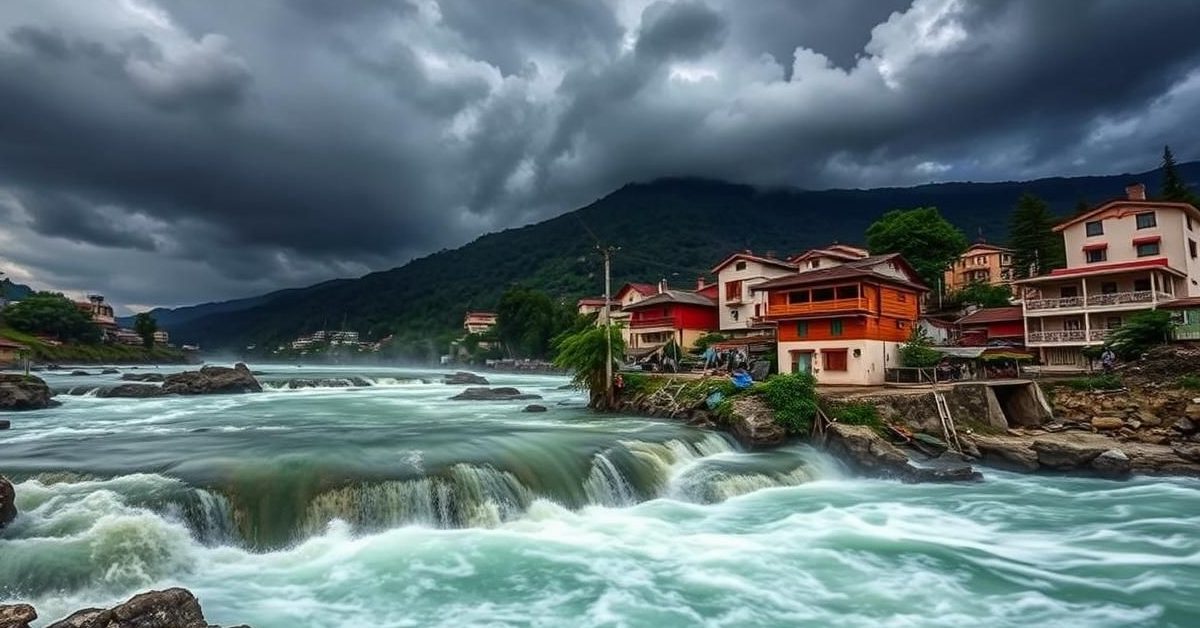The Unseen Fury: Understanding Cloudbursts and Flash Floods in India’s Vulnerable Regions
Recent events have cast a stark spotlight on the escalating threat posed by extreme weather phenomena, particularly in India’s picturesque yet precarious Himalayan states. Just days ago, the serene landscape of Himachal Pradesh was ravaged, claiming lives and leaving a trail of devastation. In Kangra, three bodies were recovered, tragically increasing the toll from a series of flash floods ignited by sudden, intense cloudbursts. Reports confirm at least four such catastrophic incidents across Kullu district, impacting areas like Banjar, Gadsa, Manikaran, and Sainj. This grim reality serves as a powerful reminder of nature’s formidable power and the urgent need to comprehend these atmospheric anomalies.
What Exactly is a Cloudburst? Decoding the Extreme Rainfall
When we speak of a “cloudburst,” we’re referring to an extraordinarily localized and intense rainfall event, an extreme weather phenomenon that unleashes a tremendous volume of water in a short duration. The India Meteorological Department (IMD) precisely defines it as precipitation exceeding 100 millimeters (or 10 centimeters) per hour over a concentrated geographical area, typically spanning just 20 to 30 square kilometers. Imagine a bucket of water being dumped over a small patch of land, rather than a steady shower – that’s the essence of a cloudburst. It’s crucial to understand that while all cloudbursts involve heavy rain, not all heavy rain qualifies as a cloudburst unless it meets these specific intensity and spatial criteria.
The Sudden Deluge: How Cloudbursts Take Shape
The very nature of cloudburst formation is one of startling rapidity, making them notoriously difficult to predict with pinpoint accuracy. While advanced tools like Doppler radars can forecast heavy rainfall up to two hours in advance, their efficacy is significantly hampered in rugged, mountainous terrain where obstructions can block vital signals. Furthermore, the conditions that trigger these downpours are transient, developing swiftly in one locale before dissipating or shifting, adding another layer of complexity to early warning systems.
The Terrifying Aftermath: Flash Floods and Landslides
The immediate consequence of a cloudburst is often a flash flood – a sudden, highly localized inundation of an area, occurring with terrifying speed. Unlike prolonged flooding from continuous rain, flash floods overwhelm landscapes almost instantaneously, especially in regions with narrow, steep river valleys where water flow accelerates dramatically. In India, particularly across the volatile Himalayan states, cloudbursts are frequently the direct catalysts for these destructive flash floods.
Adding to this peril, these swift floods often trigger landslides. This refers to the abrupt downhill movement of rock, earth, boulders, or debris. Mountainous terrains, with their inherent geological instability, soil composition, and steep slopes, are inherently susceptible to such mass movements, transforming a water event into a multi-hazard catastrophe.
Beyond Rain: The Menace of Glacial Lake Outburst Floods (GLOFs)
The threats facing India’s high-altitude regions extend beyond just cloudbursts. The ongoing retreat of glaciers, a direct consequence of a warming planet, has led to a proliferation of glacial lakes. When these large bodies of water, perched precariously in front of, on top of, or beneath melting glaciers, suddenly rupture, they unleash what is known as a Glacial Lake Outburst Flood (GLOF). These events release immense volumes of water, sediment, and debris downstream with devastating force, capable of submerging valleys, obliterating critical infrastructure like roads and bridges, and causing immense loss of life and livelihoods. Recognizing the urgency of this global challenge, the United Nations has designated 2025 as the International Year of Glaciers’ Preservation, urging collective action to safeguard these vital ice masses.
Why Hilly Regions are Hotbeds for Cloudbursts
The unique topography and atmospheric dynamics of mountainous areas like Himachal Pradesh create a perfect storm for cloudbursts. Three primary factors converge to heighten their vulnerability:
1. **Unique Wind Patterns:** As moisture-laden winds ascend mountain slopes, they are forced upwards, cooling rapidly and condensing into dense clouds.
2. **Mountain Height and Orographic Lift:** The sheer height of mountain ranges acts as a barrier. Warm, moist air currents, unable to penetrate the colossal mountain faces, are violently pushed upward. This “orographic lift” fuels intense convection.
3. **Moisture and Humidity:** Areas rich in moisture and humidity provide the essential raw material for large, saturated cloud formations.
Within these towering peaks, low-pressure zones often develop at high altitudes, drawing in clouds with considerable force. When warm, moisture-rich air collides with colder, descending air, it can trigger explosive thunderstorms. In a peculiar twist, sometimes these heavily saturated clouds, poised to release their rain, are prevented from doing so by powerful updrafts of warm air. Instead, raindrops are carried upward, growing larger as they merge with new moisture. Eventually, the sheer weight becomes too immense for the cloud to sustain, causing the accumulated water to collapse downwards in an overwhelming, instantaneous deluge – the signature of a cloudburst.
Asia’s Accelerating Warmth: Insights from the 2024 Climate Report
The increasing frequency and intensity of events like cloudbursts are not isolated incidents but are deeply intertwined with broader climate trends. The recently published *State of Climate in Asia 2024 report*, a collaborative effort by the *World Meteorological Organization (WMO)* and various regional and international meteorological bodies, paints a stark picture. The report underscores how alarming changes in key climate indicators – including surface temperature, glacier mass, and sea levels – are already unleashing profound repercussions across the continent’s societies, economies, and ecosystems.
Asia, according to the report, experienced its warmest or second warmest year on record in 2024, with its average temperature soaring 1.04 degrees Celsius above the last 30-year average. Crucially, the continent is warming at nearly twice the global average rate. This accelerated warming manifested in a barrage of extreme weather events throughout 2024, including 29 tropical cyclones, prolonged and scorching heatwaves, and devastating extreme rainfall events, with India being significantly impacted.
In India alone, the report highlights the tragic toll of extreme heatwaves in 2024, which claimed over 450 lives, with temperatures frequently ranging between 45-48 degrees Celsius and even touching 50 degrees in some locations. Furthermore, the country witnessed deadly lightning events, resulting in approximately 1,300 fatalities. The relentless melting of glaciers, with 23 out of 24 observed glaciers in the High Mountain Asia region (encompassing the Himalayas, Pamir Mountains, Karakoram, and Hindu Kush) continuing to lose mass, further exacerbates the risk of GLOFs and contributes to rising sea levels and altered regional water cycles. Even the oceans surrounding Asia bore the brunt, with marine heatwaves impacting an unprecedented nearly 15 million square kilometers, particularly severe in the northern Indian Ocean, adjacent to Japan, and the Yellow and East China Seas. These findings collectively underscore a deepening climate crisis, making our understanding of phenomena like cloudbursts and their wider impacts more critical than ever.













